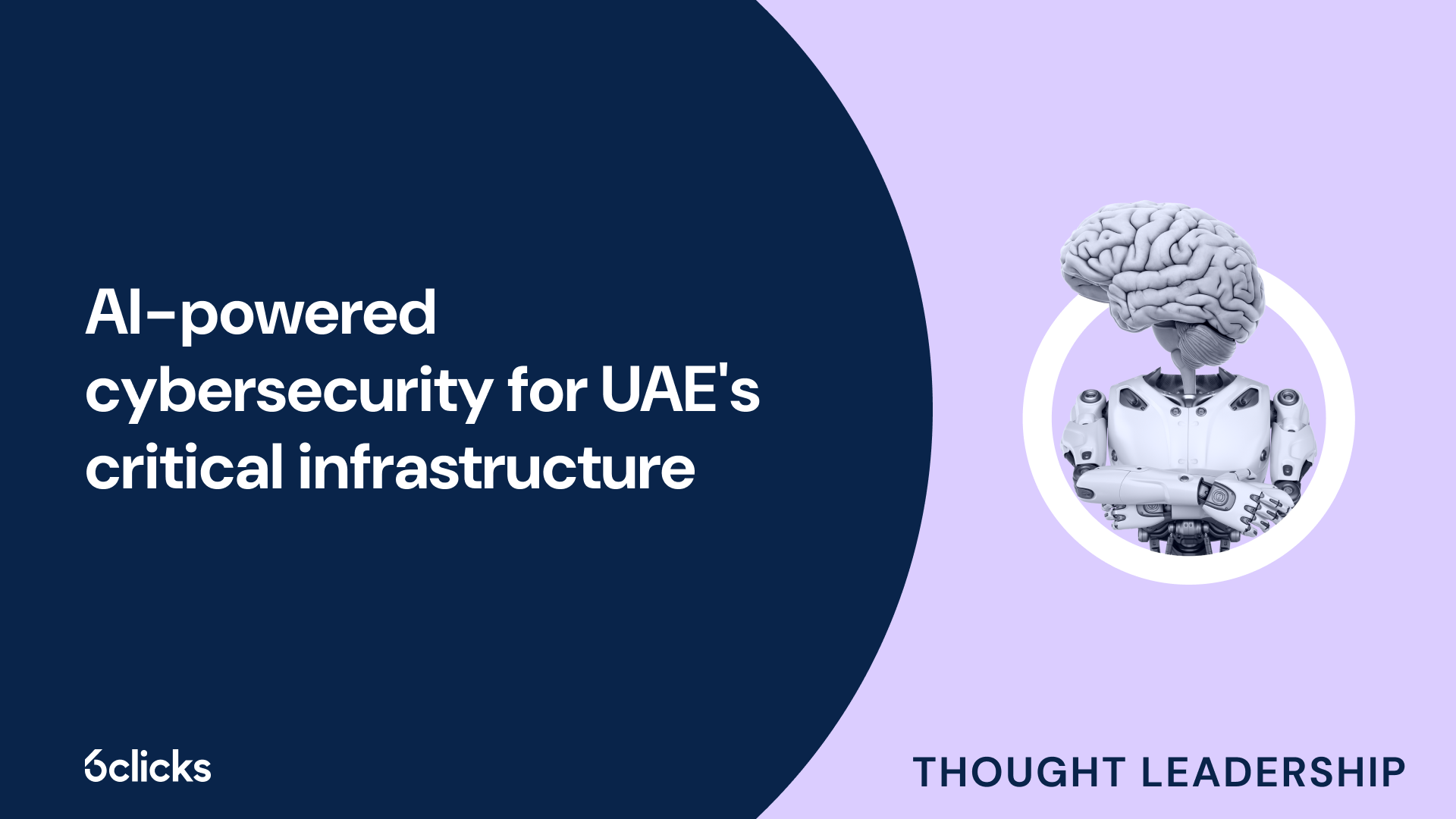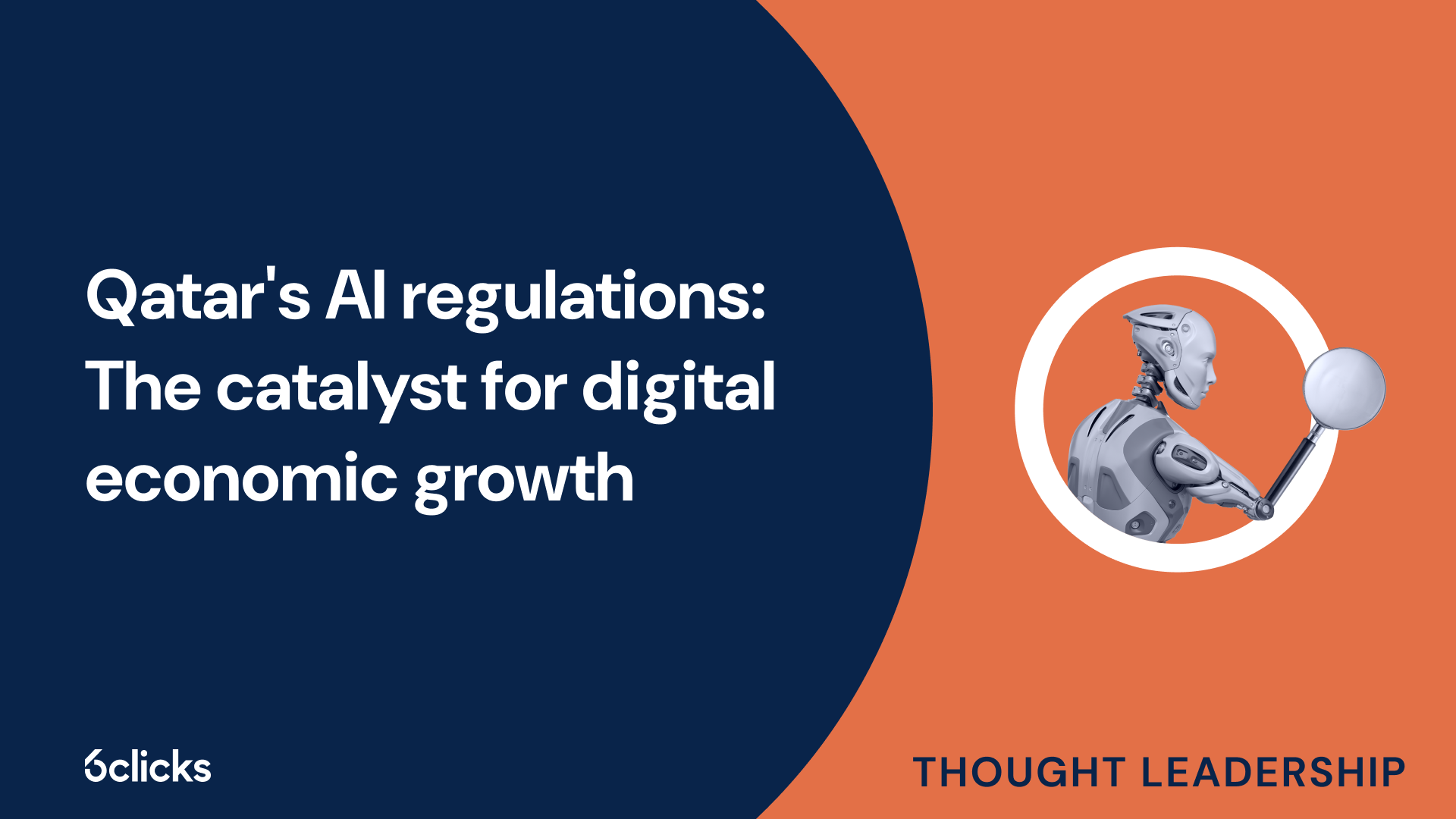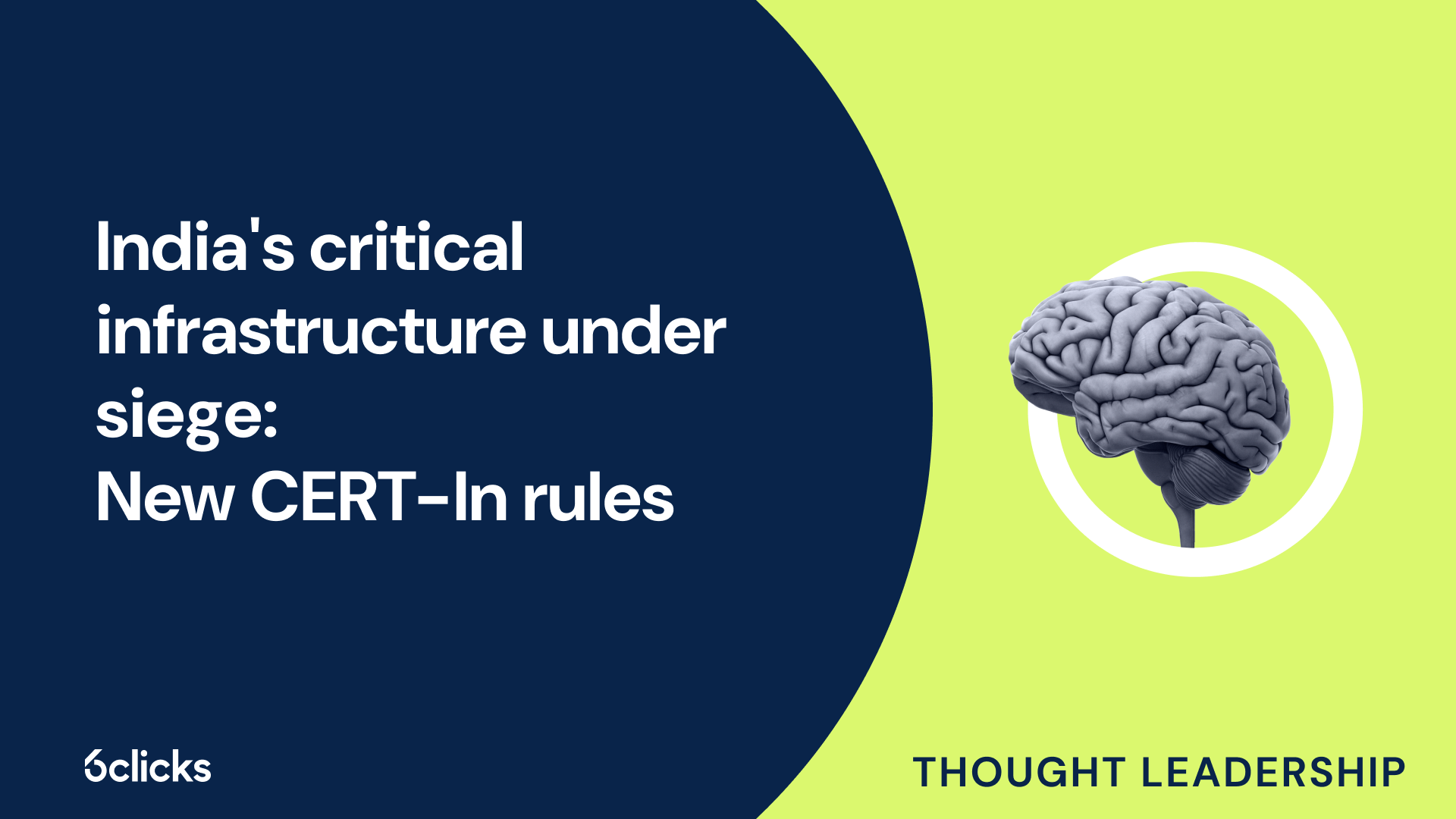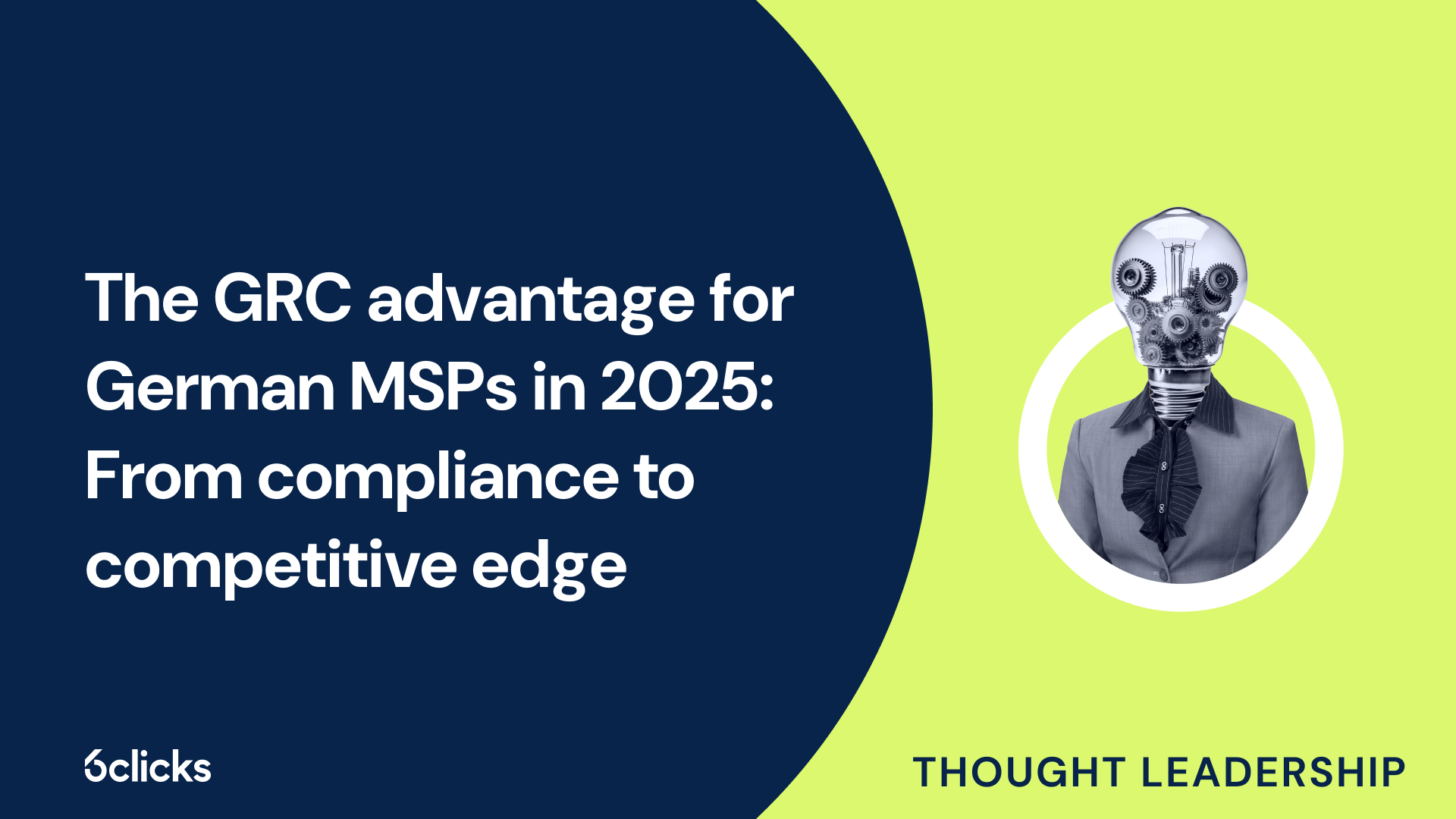The GRC buyer’s guide for 2025: Building resilience with AI-powered, federated solutions
Discover the ultimate GRC buyer's guide for 2025! Uncover how AI-powered, federated solutions transform compliance and security management for industries like government, aerospace, banking, and more. Learn about centralized control, continuous compliance, and advanced cyber GRC capabilities. Download now!
-1.png?width=200&height=249&name=Group%20193%20(1)-1.png)
The GRC buyer’s guide for 2025: Building resilience with AI-powered, federated solutions
What is enterprise risk management (ERM)?
Enterprise risk management (ERM) is a systematic and comprehensive approach that organizations use to identify, assess, and manage the risks they face in achieving their objectives. ERM provides a framework for organizations to integrate risk management into their overall business strategy and operations. By taking a proactive and holistic approach, ERM enables organizations to identify potential risks, analyze their potential impact, and develop strategies to minimize or mitigate those risks. ERM considers both internal and external factors that could affect an organization's ability to achieve its objectives, including strategic risks, operational risks, financial risks, and compliance risks. Through ERM, organizations can establish effective internal controls, set risk tolerances and risk appetites, and implement risk response strategies that align with their business objectives and risk management philosophy. Overall, ERM ensures that risk management becomes an ongoing process embedded within an organization's culture and governance structure.
The four typical objectives of ERM
Enterprise Risk Management (ERM) aims to effectively manage and mitigate risks that can impact an organization's ability to achieve its objectives. There are four typical objectives of ERM that play a crucial role in risk management practices.
- Aligning risk appetite with business strategy: ERM helps organizations establish their risk appetite, which refers to the level of risk they are willing to accept in pursuit of their business objectives. By aligning risk appetite with business strategy, ERM ensures that the organization's risk-taking activities are in line with its overall goals and objectives, helping to drive growth and success.
- Establishing an effective control environment: ERM focuses on establishing and maintaining an effective control environment within the organization. This involves implementing internal controls and risk management processes that help identify, assess, and mitigate potential risks. By doing so, ERM helps create a structured framework for managing risks across all levels of the organization, ensuring that controls are in place to avoid or limit the impact of adverse events. Fostering a culture of risk awareness and responsibility: ERM aims to cultivate a culture that promotes risk awareness and responsibility at all levels of the organization. This involves engaging the board of directors, senior management, and employees in understanding and appreciating the importance of risk management. By cultivating a risk-aware culture, ERM ensures that risk assessments are regularly conducted, potential risks are identified and evaluated, and risk responses are developed and implemented.
- Monitoring risks effectively across the organization: ERM emphasizes the importance of ongoing monitoring and evaluation of risks. This involves continuously assessing the organization's risk profile, identifying emerging risks, and monitoring the effectiveness of risk responses and controls. By continuously monitoring risks, ERM enables timely decision-making and intervention to address any potential risks that may threaten the achievement of the organization's objectives.
Objective 1: align risk appetite With business strategy
The first objective of Enterprise Risk Management (ERM) is to align risk appetite with business strategy. This means that organizations need to determine the level of risk they are willing to accept in order to achieve their business objectives. By aligning risk appetite with business strategy, organizations can ensure that their risk-taking activities are in line with their overall goals and objectives. This helps drive growth and success by ensuring that risks are managed effectively and that resources are allocated strategically. ERM helps organizations establish a structured framework for managing risks, enabling them to make informed decisions and take calculated risks that are in alignment with their business strategy.
Defining risk appetite
Risk appetite is an essential component of enterprise risk management (ERM) that defines the amount of risk an entity is willing to accept in pursuit of its goals and value creation. It refers to the level of risk that is deemed acceptable to achieve the organization's objectives without putting its viability at excessive risk.
Defining risk appetite is crucial because it sets the boundaries within which an organization operates. It helps management make informed decisions when assessing potential risks and determining the appropriate risk response strategies. By clearly defining risk appetite, organizations can align their risk management processes with their overall business strategy and objectives.
Additionally, risk appetite has a significant influence on an organization's culture and operating style. It shapes the mindset of employees and stakeholders towards risk-taking and risk management. A strong risk management philosophy promotes a risk-aware culture where employees at all levels are mindful of the potential risks associated with their actions and strive to mitigate them effectively. This, in turn, affects an organization's operating style, leading to a more proactive and risk-conscious approach in business activities.
By defining risk appetite and embedding it into the organizational culture and operating style, ERM becomes an ongoing process that is integrated into all aspects of decision-making. It ensures that risk management becomes an inherent part of the organization's core values and guides the achievement of entity objectives while safeguarding against potential risks.
Identifying and assessing risks
Identifying and assessing risks is a crucial component of enterprise risk management (ERM) as it helps organizations effectively anticipate and mitigate potential threats. This process involves systematically assessing each area of operation to identify and document risks at various levels.
At the larger level, organizations analyze strategic risks that may impact the achievement of entity objectives. This involves considering external factors, such as changes in the market or emerging technologies, and internal factors, such as the organization's capabilities and resources. By addressing these larger risks, organizations can align their risk management efforts with their overall business strategy.
Moving down to a more granular level, organizations identify and assess operational risks that may arise from specific business activities. This may involve considering potential events that could disrupt operations or cause financial loss. By documenting these risks, organizations are better equipped to develop appropriate risk response strategies.
Furthermore, organizations also consider individual projects or processes and assess the risks associated with them. This allows for a more detailed understanding of potential hazards and helps in developing risk mitigation plans at the project level.
By following a systematic approach to risk identification and assessment, organizations can effectively prioritize risk areas, allocate resources, and implement appropriate risk reduction strategies. This helps ensure that risks are addressed at various levels, from larger, more significant risks to smaller risks on the level of individual projects or processes.
Understanding the impact of risks on strategic goals and objectives
Understanding the impact of risks on strategic goals and objectives is of paramount importance in the context of enterprise risk management (ERM). Strategic risks refer to potential events or trends that can significantly impact an organization's ability to achieve its business objectives and maintain its competitive advantage. Ignoring or underestimating these risks can have severe consequences for a company's market value and overall success.
Strategic risks are dynamic and can arise from various sources. Changing consumer demand is one such risk that organizations must monitor closely. For instance, a sudden shift in consumer preferences towards eco-friendly products can render a company's existing offerings outdated, leading to a decline in market share and revenue. Similarly, the entry of new competitors with innovative business models or disruptive technologies can disrupt an industry's dynamics and pose a strategic risk to incumbents.
Social trends, such as changes in lifestyle or values, can also impact an organization's strategic goals. For example, the growing awareness of sustainable practices has prompted companies to reassess their supply chains and environmental impact to align with evolving societal expectations. Failure to adapt to social trends can result in not only reputational damage but also loss of market share as consumers increasingly seek socially responsible products and services.
Moreover, rapid technological advancements pose significant strategic risks. Enterprises across industries have to continuously evaluate the potential impact of emerging technologies on their existing business models. Organizations that fail to embrace digitalization or leverage new technologies risk losing relevance and market share to more technologically adept competitors.
Objective 2: establish an effective control environment
Establishing an effective control environment is one of the four typical objectives of Enterprise Risk Management (ERM). A control environment refers to the overall attitude, awareness, and actions of an organization towards risk management and internal controls. With this objective, organizations aim to create a climate that promotes strong risk management practices and the integration of internal controls throughout the business activities. By establishing an effective control environment, companies can ensure that their operations align with strategic objectives while effectively identifying, assessing, and mitigating risks. This objective requires a commitment from the board of directors and senior management to foster a risk-aware culture, develop ethical values, and set clear expectations for risk management processes. It also involves implementing a risk-based approach to allocate resources, define risk tolerances, establish risk response strategies, and continually monitor and improve upon the internal control framework. Through the establishment of an effective control environment, organizations can enhance accountability, transparency, and the achievement of entity objectives while minimizing the impact from potential events and achieving higher levels of operational efficiency and effectiveness.
Evaluating internal controls and policies
Evaluating internal controls and policies is an essential component of Enterprise Risk Management (ERM). Companies create policies and procedures to ensure that management carries out operations in a manner that mitigates risk and aligns with business objectives.
The evaluation process involves identifying the key risks that could potentially impact the achievement of entity objectives. This includes both internal factors, such as control deficiencies and operational risks, and external factors, such as changes in regulations or economic conditions. By identifying these risks, companies can develop a comprehensive risk profile.
Once risks are identified, companies can develop control activities to manage those risks effectively. Control activities can be divided into two categories: preventative and detective control activities.
Preventative control activities aim to prevent risks from occurring or reduce their likelihood. Examples of preventative control activities include implementing segregation of duties, regularly reviewing financial reporting processes, and establishing clear policies and procedures.
On the other hand, detective control activities aim to detect risks or errors that have occurred. Examples of detective control activities include conducting internal audits, performing reconciliations, and implementing monitoring systems to identify unusual transactions or patterns.
By evaluating internal controls and policies, companies can ensure that they have the necessary measures in place to manage risks effectively and achieve their business objectives. This ongoing process ensures that risk management remains an integral part of the organization's corporate governance and operating style.
Improving processes and systems to mitigate risk exposure
Improving processes and systems is essential for mitigating risk exposure in any organization. By implementing effective measures, companies can minimize the likelihood and impact of potential risks.
The first step in improving processes is to conduct a thorough risk assessment. This involves identifying potential risks and evaluating their likelihood and impact on the organization. By understanding the specific risks the organization faces, companies can develop targeted strategies to mitigate them.
Once the risks have been identified, it is important to evaluate the existing internal controls and policies. This helps to identify areas where improvements can be made to strengthen risk management practices. For example, conducting regular audits and reviews of control procedures can ensure that they are operating effectively and alignment with industry standards.
Enhancing processes and systems to minimize risk exposure can involve implementing new technology or automation to streamline operations and reduce human error. This could include adopting advanced analytics tools to monitor and detect unusual patterns or implementing robust security measures to protect sensitive data and information.
Regular monitoring and review of processes and systems is also crucial to ensure they remain effective over time. This includes ongoing evaluation of internal controls, policies, and risk management practices to identify areas of improvement and incorporate changes as necessary.
Objective 3: foster a culture of risk awareness and responsibility
In addition to conducting risk assessments and evaluating internal controls, another key objective of enterprise risk management (ERM) is to foster a culture of risk awareness and responsibility within the organization. This objective recognizes that managing risk is not solely the responsibility of a select few individuals, but should be ingrained in the mindset and actions of everyone within the company. By promoting a risk-aware culture, organizations can effectively identify and respond to potential risks, ultimately enhancing their ability to achieve their strategic objectives.
To foster a culture of risk awareness and responsibility, it is essential to establish clear communication channels and provide comprehensive training on risk management. This ensures that employees at all levels understand the importance of risk management and are equipped with the knowledge and skills to identify and address risks within their respective roles. In addition, organizations should promote an open and transparent environment where employees feel comfortable reporting potential risks or concerns.
Furthermore, fostering a risk-aware culture involves aligning the organization's core values and ethical principles with risk management practices. This emphasizes the importance of ethical decision-making when assessing and managing risks, ensuring that risk management aligns with the organization's overall mission and values.
By fostering a culture of risk awareness and responsibility, organizations can create an environment where risk management becomes an integral part of decision-making processes. This not only enhances the organization's ability to identify and respond to potential risks, but also promotes a proactive approach to risk management, enabling the organization to adapt and thrive in an ever-changing business landscape.
Developing training programs for employees on risk management practices
Developing training programs for employees on risk management practices is crucial for organizations to foster a culture of risk awareness and responsibility. These programs play a vital role in enhancing employees' understanding of risks and their role in managing them effectively.
These training programs provide employees with the necessary knowledge and skills to identify, assess, and mitigate risks within their respective roles. By equipping employees with a solid foundation in risk management practices, organizations enable them to contribute actively to the overall risk management efforts. This not only enhances risk awareness but also increases the sense of responsibility among employees towards managing risks.
Training programs on risk management practices also help employees understand the potential impact of risks on the organization's objectives and overall performance. This knowledge allows them to make informed decisions and take appropriate actions to mitigate risks proactively. By empowering employees with the necessary tools, organizations can create a risk-aware culture where everyone takes ownership of managing risks.
Moreover, providing training programs on risk management practices demonstrates the organization's commitment to employee development and professional growth. It enhances employee engagement, job satisfaction, and motivation, ultimately leading to improved overall organizational performance.
Objective 4: monitor risks effectively across the organization
One of the key objectives of enterprise risk management (ERM) is to monitor risks effectively across the organization. This objective focuses on establishing processes and systems to continuously identify, assess, and track risks in order to ensure that they are being managed appropriately. By monitoring risks, organizations can proactively identify emerging risks, assess their potential impact, and implement necessary risk response strategies to mitigate them. Effective risk monitoring also involves regularly reviewing and updating risk assessments, risk profiles, and risk tolerances to reflect changing internal and external factors. It enables organizations to maintain a comprehensive understanding of their risk landscape and make informed decisions to protect their business activities and achieve their strategic objectives. Monitoring risks effectively also facilitates the early detection of any gaps or weaknesses in existing risk management processes, allowing organizations to take corrective actions and continuously improve their risk management practices. Overall, by prioritizing the objective of monitoring risks effectively across the organization, organizations can enhance their ability to respond to potential events and maintain a proactive and resilient risk management framework.
Establishing a centralized system for tracking, monitoring, and reporting risks
In establishing a centralized system for tracking, monitoring, and reporting risks, enterprise risk management (ERM) seeks to ensure effective risk management across all levels of an organization. This system plays a crucial role in the achievement of entity objectives by providing a comprehensive understanding of potential risks and enabling appropriate responses.
Monitoring risks is a critical aspect of ERM as it allows organizations to stay proactive and responsive to changes. By consistently monitoring risk data, organizations can identify emerging risks, assess their potential impact, and determine the best response strategies. This enables them to adapt their business activities to mitigate potential threats and seize new opportunities.
A centralized system for tracking, monitoring, and reporting risks facilitates oversight by senior management and the board of directors. It provides a comprehensive and standardized view of risks, ensuring that decisions made at the strategic level align with the risk appetite and tolerance defined by the board. This system also enables the board and senior management to proactively identify and address any gaps in risk management processes, improving overall governance and decision-making.
Identifying key performance indicators to measure progress against goals
In enterprise risk management (ERM), identifying key performance indicators (KPIs) plays a crucial role in measuring progress against goals. KPIs are quantifiable metrics that help track the effectiveness of the ERM program and the achievement of objectives.
To begin the process, organizations need to establish clear and measurable goals related to risk vigilance, risk identification, risk action, and risk calibration. These goals should align with the organization's overall strategic objectives.
Once the goals are defined, appropriate KPIs can be identified. For risk vigilance, KPIs may include the number of identified emerging risks, the frequency of risk assessments, or the timeliness of risk reporting. For risk identification, KPIs can measure the accuracy and comprehensiveness of risk assessments or the percentage of identified risks with corresponding actions or mitigation plans. Risk calibration KPIs may evaluate the effectiveness of risk response strategies, the reduction of potential risks, or the alignment of risks with the organization's risk appetite.
Tracking these KPIs provides valuable insights into the performance of the ERM program and its contribution to achieving organizational objectives. It allows for monitoring the progress made in identifying and addressing risks, enhancing risk awareness and vigilance, and fostering a risk-aware culture.
By regularly analyzing the KPIs, organizations can identify areas for improvement, make informed decisions to optimize their risk management processes, and ensure alignment with their risk appetite and tolerance levels. KPIs serve as a benchmark for measuring success, increasing accountability, and driving continuous improvement within the ERM program.
Creating dashboards for senior management to view real-time risk information
Creating dashboards for senior management to view real-time risk information is an essential component of an effective enterprise risk management (ERM) program. These dashboards provide a visual representation of key risk indicators (KRIs) and allow for real-time monitoring of risks across the organization.
The process of designing and implementing these dashboards involves several steps. Firstly, relevant KRIs need to be identified. These are key metrics that provide insights into the organization's exposure to risks and its ability to manage them effectively. Examples of KRIs include the number of identified risks, the level of risk appetite, and the effectiveness of risk response strategies.
Next, the appropriate level of detail for the dashboards needs to be determined. This involves understanding the information needs of senior management and ensuring that the dashboards provide a clear and concise overview of the organization's risk landscape. The dashboards should present the information in a format that is easy to understand and interpret, such as graphs, charts, or color-coded indicators.
Finally, user-friendly accessibility is crucial in ensuring that the dashboards are effectively utilized by senior management. This involves selecting a user-friendly dashboard platform or software that allows for customization and ease of navigation. Additionally, training and support should be provided to senior management to ensure they understand how to access and interpret the real-time risk information presented on the dashboards.







